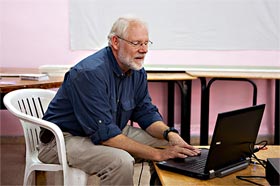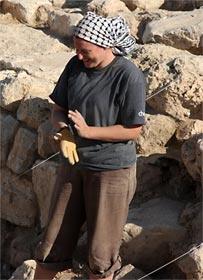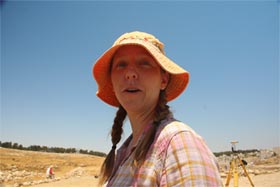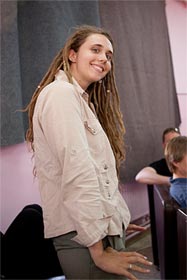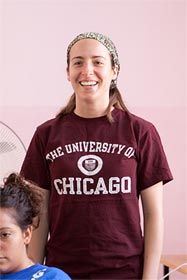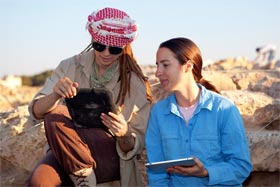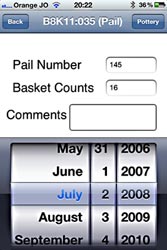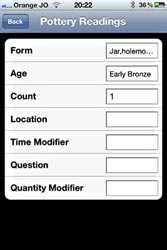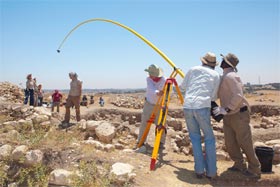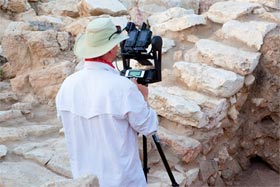Weekly Reports from Jordan
Choose Year: or Choose week
First Impressions From the Field: Week 1
By Douglas Clark, Director
First Impressions
Douglas R. Clark, Director
Jillian Logee, Photographer
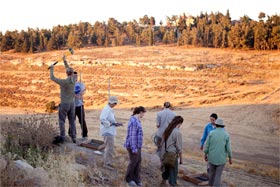
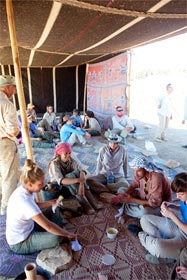 The 2012 season of excavations at Tall al-`Umayri is now underway. Core staff members have been at work since around 26 June, with most of the participants arriving by 3 July. The team of 35 (some will only be with us for half of the season) endured orientation sessions on the 4th and 5th of July, has visited sister sites Hisban and Jalul on the 5th, and has spent one day, Friday, at `Umayri learning the tricks of the trade under clear blue skies and reasonable temperatures.
The 2012 season of excavations at Tall al-`Umayri is now underway. Core staff members have been at work since around 26 June, with most of the participants arriving by 3 July. The team of 35 (some will only be with us for half of the season) endured orientation sessions on the 4th and 5th of July, has visited sister sites Hisban and Jalul on the 5th, and has spent one day, Friday, at `Umayri learning the tricks of the trade under clear blue skies and reasonable temperatures.
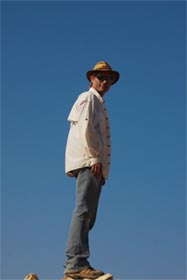
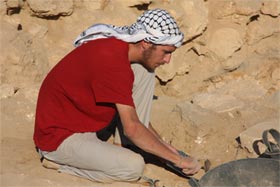 As we begin posting weekly reports on this summer’s archaeological adventure in Jordan, we are planning two to three parts for the online posts. Kent Bramlett, chief archaeologist, will write up an illustrated report on archaeologically related impressions from the week. Second, volunteers, coordinated by Tevin Maker, a journalism major from Mount Royal University in Calgary, AB, Canada, will produce their own impressions, illustrated with photos and who knows what. And occasionally I will toss in some updates about this and that.
As we begin posting weekly reports on this summer’s archaeological adventure in Jordan, we are planning two to three parts for the online posts. Kent Bramlett, chief archaeologist, will write up an illustrated report on archaeologically related impressions from the week. Second, volunteers, coordinated by Tevin Maker, a journalism major from Mount Royal University in Calgary, AB, Canada, will produce their own impressions, illustrated with photos and who knows what. And occasionally I will toss in some updates about this and that.
First impressions have been many and varied, but definitely include the following:
1) A major land-ownership issue at `Umayri threatened to derail the entire summer and the future of excavations at this most promising of Bronze and Iron Age sites in the Hashemite Kingdom of Jordan. One land owner successfully sued the government (this is where the dispute really lies – between owners and the government) for the devaluation of his property due to our excavations, leaving our summer in jeopardy. Negotiations before arriving and immediately upon arrival (Jordan-style) led to a compromise through which we are treating this summer as possibly the final summer of excavations at the site. This has forced us to rethink our excavation strategy and priorities for the summer with renewed focus on bringing everything into phase with our signature time period of the Early Iron Age (ca. 1200-1000 BC). We received our dig permit with this understanding.
Also part of the understanding is that we would put every effort possible into negotiating with land owners to allow us to continue excavating at `Umayri long, long into the future, as it is one of the most promising sites in Jordan for providing an outdoor museum to illustrate the Bronze and Iron Ages (3000-500 BC). Thus, we have launched a major campaign with the royal family; government officials including the Prime Minister, a Senator, the president of the audit bureau of the country; friends; and the land owners to resolve the problem.
2) More mundane first impressions as we arrived included initial glimpses by novices of a Middle Eastern country in the desert, a quick sense of the hospitality that pervades all of Jordanian society, a nascent grasp of the political landscape around us, an emerging awareness of what it means to visit the Holy Lands, the first rising sounds of the muezzin call to prayer broadcast from a dozen surrounding minarets at 3:45 am. Old timers feel like they have reconnected with an old friend in this country of Jordan, and settle quickly into a routine of security and well being. As they say here, “Ahlan w’sahlan” – Welcome, it is easy to be part of the family.
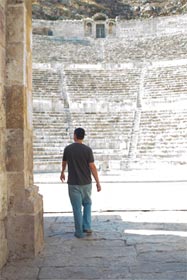
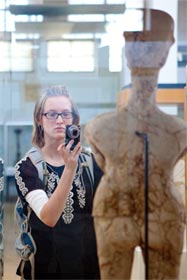 3) Our Sunday morning bus tour of sights in the capital city of Amman created first impressions of bygone glory days of the Roman period with structures like the huge Nymphaeum (public fountain with three-meter-deep pools), the massive Roman theater which seats 6,000 entertainment seekers, the grand temple of Hercules whose shadow stretched across the city below the Citadel. The group also visited the Amman Citadel Museum with collections from the early Stone Age to the Ottoman period, all crowded into small spaces. And the American Center of Oriental Research (ACOR), our North American headquarters in Jordan.
3) Our Sunday morning bus tour of sights in the capital city of Amman created first impressions of bygone glory days of the Roman period with structures like the huge Nymphaeum (public fountain with three-meter-deep pools), the massive Roman theater which seats 6,000 entertainment seekers, the grand temple of Hercules whose shadow stretched across the city below the Citadel. The group also visited the Amman Citadel Museum with collections from the early Stone Age to the Ottoman period, all crowded into small spaces. And the American Center of Oriental Research (ACOR), our North American headquarters in Jordan.
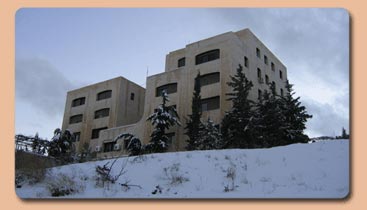
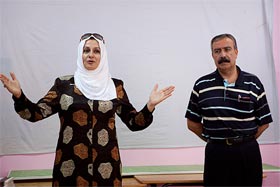
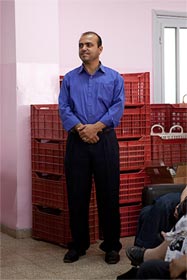 4) First impressions of the Amman Training Center (ATC), where we live during our excavations, always capture the Spartan nature of our accommodations. Not quite like the old daze (yes, daze) when real archaeologists roamed the land, camping out in tents and showering once a week whether they needed it or not. But sparing nonetheless. Especially this year. Since ATC serves as the location of an annual summer camp for 300-400 orphans (defined under United Nations guidelines for Palestine refugees) the fate of the facilities is always up in the air. Mayhem was minimal this year before we arrived, but the drain on resources and supplies like water were immediately apparent and the
4) First impressions of the Amman Training Center (ATC), where we live during our excavations, always capture the Spartan nature of our accommodations. Not quite like the old daze (yes, daze) when real archaeologists roamed the land, camping out in tents and showering once a week whether they needed it or not. But sparing nonetheless. Especially this year. Since ATC serves as the location of an annual summer camp for 300-400 orphans (defined under United Nations guidelines for Palestine refugees) the fate of the facilities is always up in the air. Mayhem was minimal this year before we arrived, but the drain on resources and supplies like water were immediately apparent and the 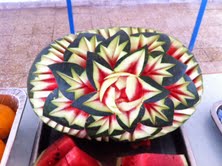 load on outdated disposal facilities was also clear. But with the spot-on commitment of ATC administrators and staff, and a huge supply truck bringing in 15 cubic meters of water, and work on the sewer drainage system, the school is running smoothly for the most part and is exceptionally clean. Everyone, clearly everyone, at ATC is out to help us. Not-so random acts of kindness happen every day in every way. This is particularly the case with the Steward of the school and long-time friend, Mohamad Ahmaru, who lives and breathes to help us, and a new head cook who has had experience in schools and hotels, and who has dazzled us with his dishes.
load on outdated disposal facilities was also clear. But with the spot-on commitment of ATC administrators and staff, and a huge supply truck bringing in 15 cubic meters of water, and work on the sewer drainage system, the school is running smoothly for the most part and is exceptionally clean. Everyone, clearly everyone, at ATC is out to help us. Not-so random acts of kindness happen every day in every way. This is particularly the case with the Steward of the school and long-time friend, Mohamad Ahmaru, who lives and breathes to help us, and a new head cook who has had experience in schools and hotels, and who has dazzled us with his dishes.
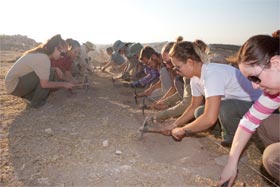
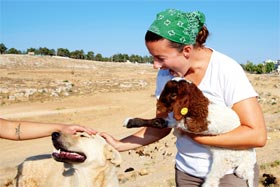 5) Impressions of our new team are enthusiastically positive. The 35 students, retirees, core staff members and other volunteers make up a congenial, collaborative group of adventurers whose initiation into the glory of dirt archaeology has begun with gusto. Thirteen are men, the rest are women. We have one married couple and will have one family. Canada and the U.S. represent the home countries of our team, and also California. Volunteers from other countries had planned to come, but finances kept some away. Dr. Kent Bramlett serves as chief archaeologist and the four field supervisors – Stephanie Brown (UC Berkeley), Carrie Duncan (University of North Carolina), Nikki Oakden (University of Calgary), and Monique Vincent (University of Chicago) – give us 100% women PhD graduate students in archaeology. The future of this project is in great hands!
5) Impressions of our new team are enthusiastically positive. The 35 students, retirees, core staff members and other volunteers make up a congenial, collaborative group of adventurers whose initiation into the glory of dirt archaeology has begun with gusto. Thirteen are men, the rest are women. We have one married couple and will have one family. Canada and the U.S. represent the home countries of our team, and also California. Volunteers from other countries had planned to come, but finances kept some away. Dr. Kent Bramlett serves as chief archaeologist and the four field supervisors – Stephanie Brown (UC Berkeley), Carrie Duncan (University of North Carolina), Nikki Oakden (University of Calgary), and Monique Vincent (University of Chicago) – give us 100% women PhD graduate students in archaeology. The future of this project is in great hands!
6) Another first impression arises from the huge shift the `Umayri excavations have made from paper recording techniques (through 2010) to a totally digital data-gathering system, using iPads and iPods. Matt Vincent, doctoral student at the University of California San Diego, has worked with other students to create programs which utilize our extensive recording system (used now by a dozen other digs), making the recording process as easy as clicking on a drop-down menu of possible options. All devices have protective cases to keep out the dust. In addition, because we hope to record everything as completely as possible, especially if this is (God forbid!) our final season at `Umayri. We are thus using three macro digital systems to record as accurately and photographically sensitively as possible: 1) a 40-foot photographic boom with remotely controlled camera to capture top views of excavated areas and to geo-rectify all of our architecture; 2) a gigapan camera system which records in a 360-degree circle various buildings and rooms in stereo (two cameras) so that the finished product can be viewed with 3-D glasses to capture the real feeling of being in the room or building; 3) a LiDar unit which also records in the round and provides us with the most sophisticated and accurate digital data available.

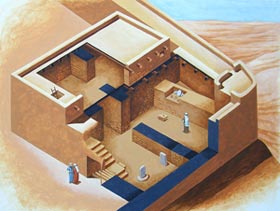 7) With two new DoA representatives assigned to our project, we shared first impressions all around. Adnan Rafayah is Curator of the DoA national storeroom for objects and artifacts excavated in the country – he just located 25 objects lost in the warehouse two summers ago and a large ceramic storage jar we reconstructed and returned several years ago. Abdulrahim Al-Dwikat is director of the Citadel Museum in downtown Amman – he just agreed to display the religious niche, altar, standing stones, and objects from our Late Bronze Age temple/palace complex. We could not have asked for two better people, even if we have regularly enjoyed the expertise and support of several great DoA representatives over the years.
7) With two new DoA representatives assigned to our project, we shared first impressions all around. Adnan Rafayah is Curator of the DoA national storeroom for objects and artifacts excavated in the country – he just located 25 objects lost in the warehouse two summers ago and a large ceramic storage jar we reconstructed and returned several years ago. Abdulrahim Al-Dwikat is director of the Citadel Museum in downtown Amman – he just agreed to display the religious niche, altar, standing stones, and objects from our Late Bronze Age temple/palace complex. We could not have asked for two better people, even if we have regularly enjoyed the expertise and support of several great DoA representatives over the years.
Watch for further impressions in the weekly reports to follow.
